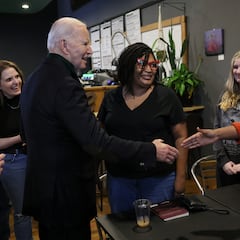How does a caucus work? Who can vote and what do they decide?
The 2024 elections are set to kick off with voters in Iowa poised to choose who will be on the GOP ballot in November. Here’s how the caucus system works…

Republican voters in Iowa will be braving the extreme cold on Monday 15 January to choose who will be on the ballot in November as the GOP candidate for the US presidency. This will be the first primary in the nation and we will break down how the process works and what you need to know for the event.
Since President Biden is seeking re-election, no primary for the party will be held in Iowa. The Democratic primary in the state was sidelined in favor of South Carolina going first, taking place on 3 February. Instead, Democratic voters in the state will mail in a ballot by Super Tuesday, which will take place on 5 March.
In the United States, there are two main ways to choose who will be the presidential contender for each party. In the case of Iowa, they use caucuses. So it begs the question for many… How exactly do they work, and why are they so important for the general elections? Let’s dive in.
It was fun breaking down the #IowaCaucus process with @PeteHegseth on Fox & Friends! pic.twitter.com/aE5bYbTCLh
— Mark Lucas (@lucasiowa) January 14, 2024
How does a caucus work? Who can vote and what do they decide?
Caucuses are meetings political parties hold to discuss matters of interest and establish the preferred presidential candidate for the November general elections. Unlike primaries, which state governments organize, caucuses are not state-organized, and only party-affiliated individuals can vote. This means that independent voters in Iowa are not allowed to participate in the primary process.
On Monday 15 January 2024, GOP voters will head to caucus locations across the state. They will be greeted by representatives from each of the campaigns. In some cases, the candidates themselves will make an appearance to make their pitch to caucus attendees. If not, a representative will provide a short speech as to why voters should support their favored candidate. After these speeches have been delivered, attendees will cast their votes, and the winner is announced.
What is the difference between an open and closed primary?
Each state is allowed to set its own rules for how primary elections are conducted. Oftentimes, these rules are influenced by the Republican and Democratic party organizations active in that state, and typically, the parties are given the choice of how they treat independent voters. Below we will discuss the rules for presidential elections as they may differ for state and local elections.
States with closed primaries
In eight states, voters without party affiliation cannot vote in the primaries.
States with closed primaries
- Delaware
- Florida
- Kentucky
- Nevada
- New Mexico
- New York
- Pennsylvania
- Wyoming
These are what are known as closed primaries: registered Democrats vote for Democrats, registered Republicans vote for Republicans, Greens for Greens, Libertarians for Libertarians... While this type of primary alienates non-party-affiliated voters, party members are given far more control over the nomination process. However, as the electorate disengages with the two main parties, blocking independent voters from participation could suppress turnout in the general election if voters feel that the candidates do not represent their values and interests.
States with partially-closed primaries
Many states conduct partially closed primaries, meaning independent voters can vote in the primary if the party permits it.
States with partially-closed primaries
- Connecticut
- Idaho
- Kansas
- Maryland
- North Carolina
- Oklahoma
- Oregon
- South Dakota
- Utah
- West Virginia
This helps the parties to prevent voters from opposing parties from participating in the primary, but it also includes independents who may want to express their support for specific candidates. In certain situations, political parties can increase their odds of winning in the November elections by allowing non-party members to participate in the primary elections. This may help their candidates gain support from a wider range of voters. However, there is a possibility that party members may feel their voices are being disregarded if their preferred candidate loses to someone who relied heavily on independent voters.
States with partially-open primaries
On the other side of the spectrum are states that hold partially open and open primaries. According to the National Conference of State Legislators (NCSL), in partially open primaries, voters are allowed “to cross party lines, but they must publicly declare their ballot choice or their ballot selection may be regarded as a form of registration with the corresponding party.”
States with partially-open primaries
- Illinois
- Indiana
- Iowa
- New Jersey
- Ohio
This system not only allows independent voters to participate but also enables voters registered with a party to vote in a different party’s primary. However, only one ballot is allowed to prevent electoral manipulation. Some states only allow party-affiliated voters to participate, while others have partially-open primaries or open primaries to unaffiliated voters. The NCSL distinguishes between these types of primaries. In Arizona, Colorado, Kansas, Maine, Massachusetts, New Hampshire, North Carolina, and Rhode Island, independent voters can cast a ballot, but the rules differ from state to state. For example, New Hampshire and Colorado require voters to declare which primary they would like to vote in.
States with open primaries
States with open primaries offer voters greater choice in who they wish to see on the November ballot. This is the most common type of primary.
- Alabama
- Arkansas
- Georgia
- Hawaii
- Michigan
- Minnesota
- Mississippi
- Missouri
- Montana
- North Dakota
- South Carolina
- Tennessee
- Texas
- Vermont
- Virginia
- Wisconsin
Related stories
In California and Washington, voters receive a ballot with the names of all those seeking the office, regardless of party affiliation. Once the voters are counted, the two candidates that received the greatest support will appear on the November ballot. This can lead to situations where two Democrats or two Republicans make it to the general election, but it is considered a strong way to include the opinions of independents in the primary election process.
Louisiana does not hold a primary and instead allows voters to select from a long list of candidates on election day. But, if no candidate secures at least fifty percent of the vote, a run-off with the two candidates that received the highest number of votes is held.

